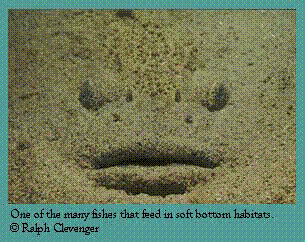Shallow Soft Bottom Habitats
I. Physical Features of Shallow Soft Bottom Communities (i.e.
at Scuba depths, to 30-40 meters)
 Movement of bottom sediments by large waves is a dominant
physical process influencing the structure of benthic infaunal communities
along the shallow Scuba-accessible continental shelf (Oliver et al. 1980). Wave action produces
a coarse, poorly consolidated, well-sorted (i.e. low variation in grain
size), and therefore easily moved beach deposit behind the surf zone. Large waves
lift these surface sediments into a granular suspension tossed shoreward
and then seaward by the passing waves (Bascom 1964, Clifton et al. 1971).
Extreme storm waves can remove as much as a meter of surface sediments at
water depths greater than 10 meters. The physical stability of the beach
deposit increases with increasing water depth as wave-generated bottom currents
decrease. As a result, bottom sediments grade from coarse to fine sand with
increasing water depth and decreasing wave disturbance (Hodgson and Nybakken
1973, Oliver et al. 1980).
Movement of bottom sediments by large waves is a dominant
physical process influencing the structure of benthic infaunal communities
along the shallow Scuba-accessible continental shelf (Oliver et al. 1980). Wave action produces
a coarse, poorly consolidated, well-sorted (i.e. low variation in grain
size), and therefore easily moved beach deposit behind the surf zone. Large waves
lift these surface sediments into a granular suspension tossed shoreward
and then seaward by the passing waves (Bascom 1964, Clifton et al. 1971).
Extreme storm waves can remove as much as a meter of surface sediments at
water depths greater than 10 meters. The physical stability of the beach
deposit increases with increasing water depth as wave-generated bottom currents
decrease. As a result, bottom sediments grade from coarse to fine sand with
increasing water depth and decreasing wave disturbance (Hodgson and Nybakken
1973, Oliver et al. 1980).
| < Previous Shallow Soft Bottom Habitats TOC |
||
